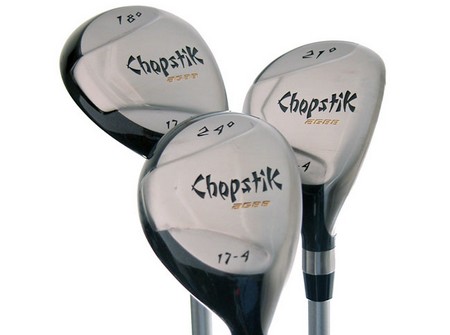The elegant, matched set of clubs with three woods and ten irons has long been the popular choice of golfers, but today more and more of them are customizing their basic set by adding new clubs and replacing old ones until they get the set that best matches their playing abilities and course conditions.
Utility clubs are designed to perform specific tasks and broaden your range of shotmaking. While most utility clubs make a lot of sense, you will have to make a choice by exclusion, or else you may easily end up with 18 or more clubs in your bag.
Three, four or five woods are standard today, you may also want to add a trouble-shooter to hit out of the rough, then your set of irons, not to forget the putter, specialty wedges and maybe a chipper — all that adds up to a lot of weight and probably many more clubs than your bag can hold or the Rules of Golf allow.
I recommend you rather add more woods, and leave your long irons at home, unless you can handle them very well. And, if you want to listen to my advice, consider carrying three wedges in your bag. They are a big bonus for almost any player anywhere.
5-Woods
Probably the most popular utility club in the bag is the 5-wood. Today, most standard sets come with a 5-wood rather than a 4-wood, and rightfully so. I believe that virtually all golfers should carry a 5-wood. It is easy to use and it is versatile, because you can use it on the fairway and in the short rough, and even off the tee on longish par three’s.
The 5-wood is designed to hit the ball about as far as a 3-iron. With an angle of about 25° it has more loft than the iron, but its longer shaft allows you to create more clubhead speed resulting in a higher, softer shot compared to the lower, boring flight of the 3-iron with more roll.
A variation of the 5-wood comes with two rails on its sole running from front to back. It first emerged in the mid 1970s when Cobra Golf marketed the Baffler. The rails allowed the club to skid rather than dig into the turf, making it easier to hit out of the rough.
If you belong to the vast majority of golfers who cannot hit their long irons high, then the 5-wood is a necessity. Even Raymond Floyd carried a 5-wood when he won the 1976 U.S. Masters. He used it to hit high, soft approaches to Augusta National’s back-nine par five’s, shooting a total of 271, 17 under par, and equalling Jack Nicklaus’ tournament record.
7-Woods
More recently, clubmakers introduced the 6-wood and the 7-wood. The latter is widely used for trouble-shots out of the rough, where height and distance are important.
Lee Trevino, one of golfs great shotmakers, carries a 7-wood in his bag, because it allows him to hit high, floating shots with his regular swing, which usually generates rather low trajectories.
With the 7-wood, you can let the club do the work. You can make a good, solid contact, and the club will get the ball in the air. Like the 5-wood, the 7-wood also comes in the rail-soled version to help with the shots out of the deeper rough.
1-Irons
Although this long accuracy club is far more common today than it was several years ago because more golfers are able to hit the perimeter-weighted model than the earlier blades, it is a utility club for good amateurs and professionals only.
The very best players use this flat-faced club with only 16° or 17° loft to hit the ball about as far as their 3-wood, but much more accurately, because the shaft of the iron is about three inches shorter than that of the wood. While the 1-iron may be hit from the fairway, it is mainly used as a driving iron on short, tight par four’s. Some golfers use it also to keep the ball in play on long par five’s.
Sand Wedges
A good sand wedge must have a lot of bounce, a trailing edge that lies lower than the leading edge, and a rather broad sole allowing you to get the ball out of the sand quickly, without digging in too deeply, and preventing fluffed shots.
Bounce is the main difference between sand wedges and pitching wedges, making the former very difficult to pitch with on firm fairways. It is designed to bounce off these, resulting in a thinned shot.
While most sand wedges come with broad soles, the good golfers prefer rather narrow soles, because these clubs allow more precise and better controlled shots, since you can hit closer to the ball, imparting more backspin.
When choosing a sand wedge you have to keep the conditions on your home course in mind. The softer the sand, the more bounce you need and the broader the sole should be, and vice versa.

As bunker shots usually require finesse, many tour players, including myself, fit flexible shafts to their sand wedges. This way, you can just use your hands and let the club do the work. For the same reason, your wedge shouldn’t be too heavy. Watch out, as a lot of them are.
Chippers
Chipping irons come with a shaft that is about as long as that of a putter and the loft of a 5-iron. They are designed for chip-and-run shots from the apron or the vicinity of the green when you have a lot of green to cover.
Chipping irons allow the golfer to play high percentage shots which will get the ball close to the hole in most cases. However, the chipping iron is an extravagance, as you may have to leave another club at home to keep to the allowed maximum. You should be able to produce the same shots with your mid irons.